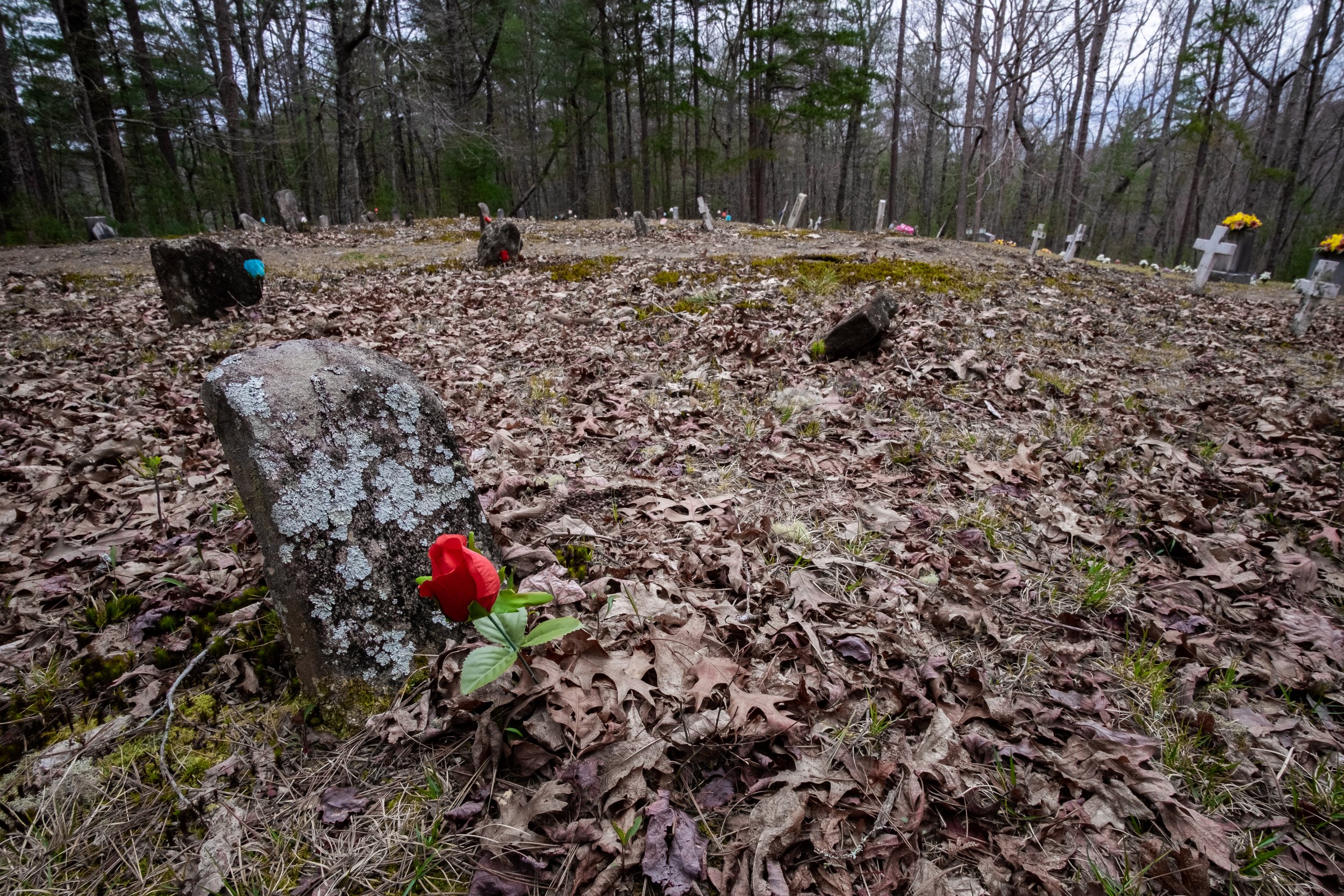The witch tree of tilley bend
@coreypeltonphotography
The blank tombstone rests beneath the tree from which she was hung. The hillside is dotted with simple stones born of the wombs she cursed.
Feeling light and refreshed by the warm spring evening, Holly and I decided to wind down unknown roads. A sign had indicated a canoe launch along the Toccoa and I am always up for a trip to the river. Miles into our wanderings found us deep in the oak canopy and cresting a ridge before we would drop down into the rhodedendron-laden river bottom. To the right, away from any seeming civilization, was Tilley Baptist Church. Unlike the typical rural white clapboard churches that dot the North Georgia landscape, this church was a deep, dark brown with windows that had been boarded up presumably guarding the internals from vandals. It was too enticing to not stop and explore.
The small hill behind the church revealed the centuries of family loss as tombstones gave way to dates going back to the early 1800’s. Old deeply-wrinkled names like Pollie, Enoch, and Gilbert were etched and chiseled into marble and limestone. A large tree stood in the middle of the yard. Beyond, there were the small stones, blank of any markings. Short graves. Shallow holes. Little people. Children. Stillborns. We spoke briefly and somberly noting how numerous these stones. Silenced by our unexpected find, we drove off toward the river.
What was an intriguing stop along a pleasant drive became a haunting story of feuds, witchcraft, a rope, and a limb.
The week after our brief sojourn through the twisting roads, I was speaking with a young Baptist pastor whose family goes back six generations in this wild Appalachian area. I mentioned our stop. “Oh, that’s where Elizabeth Tilley was hung for witchcraft.” WHAT? I thought the witchcraft trials were an isolated hyper-Puritan event in Salem, Massachusetts. I thought the scarlet letter was a New England thing.
From a history account by Clay Ramsey:
On the other side of the ridge from Tilley Bend, the Stanley family, originally from western North Carolina, formed a Settlement. Over the years, friction developed and then violently erupted at the turn of the twentieth century when a group of Stanleys shot into the Tilley Church during services, killing the minister and several of the congregants, among them a daughter belonging to Elizabeth Jane Tilley Bradley. In retaliation, a band of Tilleys invaded the Stanley Settlement, murdering several of their number, including the husband of another of Elizabeth Bradley’s daughters. Elizabeth, of Creek ancestry, reportedly put a curse on both families.
For a full year, no babies survived in either settlement. Every child was miscarried, stillborn or died in early infancy. Only a witch could have that power, they believed. So a mob strung her up in a tree at the center of the Tilley cemetery. Before she died, she promised to return. They buried her at the foot of the tree where she fell. She was supposedly buried facing west, not accorded an eastern orientation by Christian tradition. Another year passed with the same degree of infant mortality, so the same mob killed her sister-in-law Mary, believing Elizabeth’s dark soul had found a haven in Mary’s body and continued her vindictive project from beyond the grave.
@coreypeltonphotography
The short decades through which I’ve lived have seen a lot of change. I write this haunting account on a MacBook. On it I can not only write, but research any topic from how to hand whip finish a pheasant tail nymph to the location of a particular grave site in Southern Appalachia. I can communicate with anyone, anywhere in the world and actually see them in real time. While typing I can speak over my shoulder . . . “Alexa, play Billy Joe Shaver” . . . and Billy Joe is immediately filling my living room telling me I’ll miss him when he’s gone.
Though we have new technology, we have the same sort of heart haunts and curses as Tilley Bend. Meth has replaced moonshine. Abuses fill communities. We blame and murder even within the church which is commissioned with a message of reconciliation. Human nature marches on leaving in its path a swath of stories both beautiful and broken. I want to take note and listen to the stories. Learn from them. We are the product of community stories for good and for ill. Knowing our communities, and our place in the community, helps us to know how to interact. If we are willing, we can be open to hear the hurts, desires, divisions, and needs. It’s easy to stand outside the communities we do not understand and take pot shots into the unknown. Rather than firing into sanctuaries or conjuring curses against others, we can become avenues of grace and mercy to heal rather than harm.
@coreypeltonphotography
“Hear, my son, and accept my words, that the years of your life may be many. I have taught you the way of wisdom; I have led you in the paths of uprightness. When you walk, your step will not be hampered, and if you run, you will not stumble. Keep hold of instruction; do not let go; guard her, for she is your life.”
Proverbs 4:10-13



